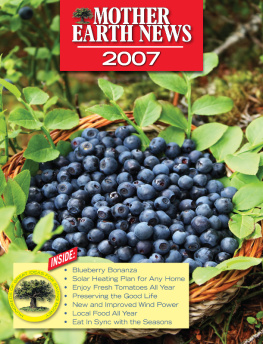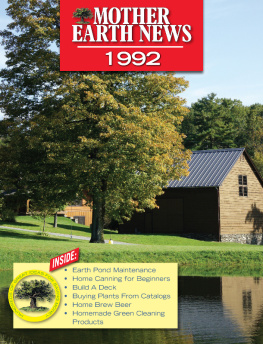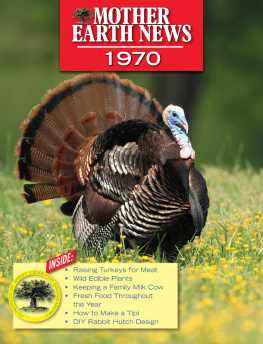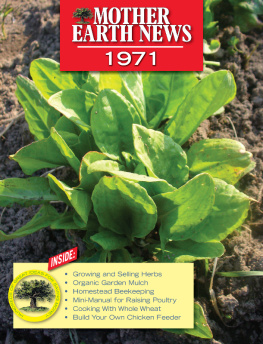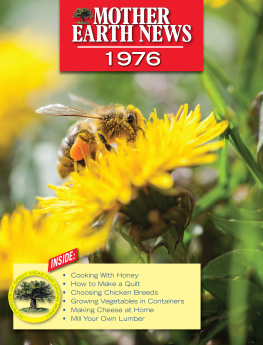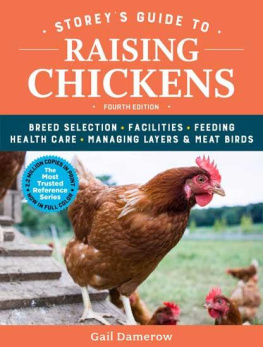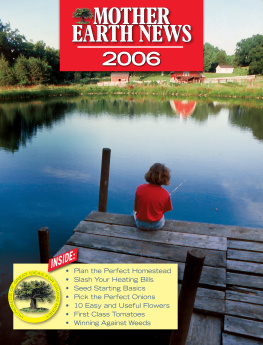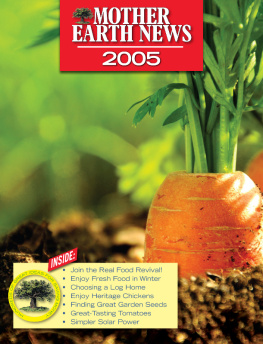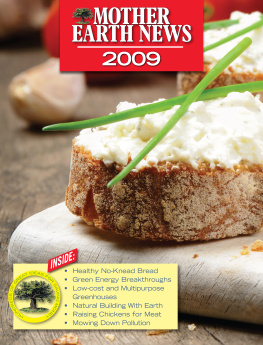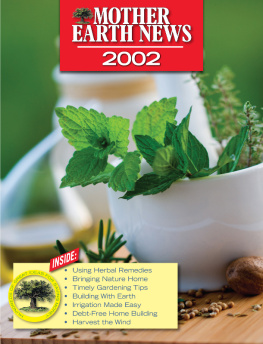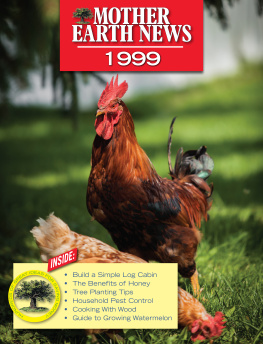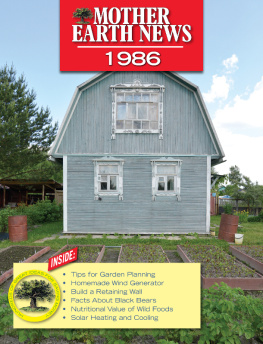Mother Earth News - Mother Earth News 2007
Here you can read online Mother Earth News - Mother Earth News 2007 full text of the book (entire story) in english for free. Download pdf and epub, get meaning, cover and reviews about this ebook. year: 2007, publisher: Mother Earth News, genre: Science / Home and family. Description of the work, (preface) as well as reviews are available. Best literature library LitArk.com created for fans of good reading and offers a wide selection of genres:
Romance novel
Science fiction
Adventure
Detective
Science
History
Home and family
Prose
Art
Politics
Computer
Non-fiction
Religion
Business
Children
Humor
Choose a favorite category and find really read worthwhile books. Enjoy immersion in the world of imagination, feel the emotions of the characters or learn something new for yourself, make an fascinating discovery.
- Book:Mother Earth News 2007
- Author:
- Publisher:Mother Earth News
- Genre:
- Year:2007
- Rating:5 / 5
- Favourites:Add to favourites
- Your mark:
- 100
- 1
- 2
- 3
- 4
- 5
Mother Earth News 2007: summary, description and annotation
We offer to read an annotation, description, summary or preface (depends on what the author of the book "Mother Earth News 2007" wrote himself). If you haven't found the necessary information about the book — write in the comments, we will try to find it.
Mother Earth News 2007 — read online for free the complete book (whole text) full work
Below is the text of the book, divided by pages. System saving the place of the last page read, allows you to conveniently read the book "Mother Earth News 2007" online for free, without having to search again every time where you left off. Put a bookmark, and you can go to the page where you finished reading at any time.
Font size:
Interval:
Bookmark:


Seven steps to growing superior spears, year after year.
Fresh from the garden, asparagus is the very essence of spring. The sweet, slender spears are at their best lightly steamed and topped with a bit of butter and maybe a drop of lemon juice. Of course, you can enjoy your bountiful crop in plenty of other ways, too: sauted, roasted, grilled, in sauce or microwaved, alone or with other veggies in soups, stir-fries and salads. Any way you slice it, asparagus is one of the most delicious vegetables you can grow.
But the beauty of asparagus is more than skin deep. One of the few perennial vegetable crops, asparagus comes back year after year, producing pounds of succulent spears for 15 to 20 years or more. In fact, when it comes to productivity, asparagus is difficult to top. A modest planting of 25 all-male crowns (dormant roots) will yield up to 20 pounds of edible spears per year - thats 400 pounds or more over a 20-year period! And its simple to store your bounty of spring asparagus in the freezer - just blanch it in boiling water, then chill in ice water before you pop it in the freezer.
Asparagus is not difficult to grow, either. While it takes some time to get a crop started, if you choose your variety and site wisely, then provide basic care as outlined here, youre on your way to decades of good eating.
1. For highest yields, choose all-male varieties. Until about 20 years ago, all asparagus varieties were a mixture of male and female plants. But Rutgers University researchers developed a method for propagating only the male plants (the female plants produce seeds). These all-male asparagus varieties - including Jersey Giant,Jersey Supreme and Jersey Knight- produce up to three times more than older, open-pollinated male/female varieties, such as Mary Washington.
Thats because they put all of their energy into producing spears rather than seeds, according to Chee-kok Chin, a professor of plant biology and pathology at Rutgers. That also means male plants do not produce volunteer seedlings, which compete against the established plants and reduce yields. All-male hybrids also are more disease resistant than older varieties. In fact, one of the best ways to avoid asparagus rust, a fungal disease that reduces yields, is to plant rust-resistant varieties, several of which are listed in .
2. Take time to make a cozy bed. Remember that your asparagus will call this site home for many years to come, so its best to choose a good location and prepare it carefully, says Mathieu Ngouajio, assistant professor of horticulture at Michigan State University.
To avoid disease problems, choose a site where corn or asparagus did not grow the year before, Ngouajio says. If you can plant a cover crop, such as sorghum or rye, in the area where you plan to plant asparagus, youre in luck. A cover crop [turned into the soil before planting] will increase the soils organic matter, which is very beneficial to asparagus, he says.
Native to warm climates, such as Asia Minor and the Mediterranean region, asparagus thrives in full sun and rich, well-drained soil. Incorporate plenty of high-quality, aged compost into your asparagus site to improve drainage, boost soil fertility and reduce the chance of soil-borne fungal diseases, such as fusarium crown and root rot. If you dont have compost, add grass clippings or shredded leaves. Planting in raised beds also will improve drainage.
You may want to test your soil to be sure the pH level is in the neutral range of 6.5 to 7.5. Plant pathologists have found that lower pH values may promote fusarium disease in asparagus. If the tests show a low pH, the testing lab can tell you how much limestone to add to your soil in order to neutralize the acidity.
3. Get a jump on weeds. They can be one of the biggest challenges for organic asparagus growers. To reduce perennial weed problems, be sure to eliminate them from the site before planting, and be vigilant about routing them out in years to come.
Before we planted our new asparagus bed, we prepared the soil carefully, says Charlotte Johnson, co-owner with her husband, Glen, of Mother Flight Farm in Mt. Vernon, Wash. The Johnsons decided to start a new asparagus patch after their previous, 15-year-old patch became hopelessly invaded by quack grass and thistles, possibly brought in with some straw mulch.
After tilling the area, we allowed the dormant weed seeds to germinate, then burned them off with a flame weeder before we planted the asparagus. Now that their patch is becoming established, the Johnsons stay on top of any new weeds by flaming the entire bed in late fall to winter, after the asparagus has gone dormant.
Other growers find that a combination of cultivation and mulching does the trick. In a five-year trial of organic versus conventional asparagus culture, conducted by Mark Hutton, extension vegetable specialist at the University of Maine, weeds were kept at bay by applying a thin layer of bark mulch around plants and cultivating between rows. After the final harvest this year, we also did a shallow (1-inch deep) cultivation with a tiller over the entire area to eliminate grasses, he says.
In cold locales, such as Gene Thiels Prairie Creek Farm in Joseph, Ore. (elevation 4,150 feet), black plastic mulch not only stops weeds, but also warms soil and conserves moisture. Thiel says the 4-foot-wide perforated plastic, used between rows, warms the soil enough to allow him to harvest spears two weeks earlier than usual in the spring.
4. Plant in trenches. After the days have warmed to about 50 degrees, plant asparagus crowns in trenches, 6 to 12 inches deep, and about 12 inches wide. (Use the shallower depth for heavy clay soils, Ngouajio says.) By starting your asparagus crop with crowns, youll be able to harvest them a year earlier than if you plant seeds. Spread finished compost in the bottom of the trench, then space the crowns about 12 to 18 inches apart inside the trench, mounding the soil a bit beneath each crown. Cover the crowns with about 2 inches of soil. Gradually add more soil (mixed with compost, if available) over the next four to six weeks as the plants grow, until the trench is level with the surrounding soil.
5. Resist the temptation to harvest spears the first season! For the best future harvests, allow the underground crowns to become well-established during the first year or two after planting. If you do not harvest the spears (which are actually the plants newly emerging shoots), they will develop into tall, attractive plants with lacy leaves.
The vegetative part of asparagus - the tall, leafy growth sometimes called ferns- is the part that captures sunlight and energy, which is stored in the crowns. The more energy stored in the crowns, the better your crop will be the following year, explains Thomas Orton, extension vegetable specialist with Rutgers Cooperative Extension in New Brunswick, N.J.
Its important that a gardener look at their asparagus plants and not push them before they are ready, says Robert Dufault, professor of horticulture and vegetable physiology at Clemson University. For instance, if the plants ferns grew lush and tall (about shoulder-height) the first year, its OK to harvest the spears for about two weeks the second spring (instead of the usual six to eight weeks), Dufault says. He also recommends waiting one more year before harvesting if the spears did not grow that tall, or if new emerging spears look spindly, to ensure robust plants the following year.
Font size:
Interval:
Bookmark:
Similar books «Mother Earth News 2007»
Look at similar books to Mother Earth News 2007. We have selected literature similar in name and meaning in the hope of providing readers with more options to find new, interesting, not yet read works.
Discussion, reviews of the book Mother Earth News 2007 and just readers' own opinions. Leave your comments, write what you think about the work, its meaning or the main characters. Specify what exactly you liked and what you didn't like, and why you think so.

